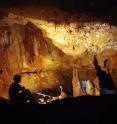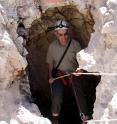Anthropology: Ancient skull from Galilee cave offers clues to the first modern Europeans
Related images
(click to enlarge)
The discovery of a 55,000-year-old partial skull in Northern Israel provides new insights into the migration of modern humans out of Africa. The rare find is reported in the journal Nature this week by an international team of Israeli, North American and European researchers. A key event in human evolution was the expansion of modern humans of African origin across Eurasia, replacing all other forms of hominin (humans and their predecessors), around 40,000-60,000 years ago. However, due to the scarcity of human fossils from this period, these ancestors of all present-day non-African modern populations have largely remained a mystery.
Now, researchers describe a partial skull that dates to around 55,000, which was found at Manot Cave in Israel's Western Galilee. The Manot Cave was discovered in 2008 during construction activities that damaged its roof. Rock falls and active stalagmites had apparently blocked the initial entrance to the cave for at least 15,000 years. The Hebrew University of Jerusalem's Cave Research Center conducted an initial survey of the cave and reported the findings of archaeological remains.
Prof. Israel Hershkovitz of Tel Aviv University led the anthropological study of the skull, and led the excavation together with archaeologists Dr. Ofer Marder of Ben-Gurion University, and Dr. Omry Barzilai of the Israel Antiquities Authority.
The skull has a distinctive "bun"-shaped occipital region at the back. In this way its shape resembles modern African and European skulls, but differs from other anatomically modern humans from the Levant. This suggests that the Manot people could be closely related to the first modern humans that later colonized Europe.
The specimen also provides evidence that both modern humans and Neanderthals inhabited the southern Levant during the late Pleistocene, close in time to the likely interbreeding event between modern humans and Neanderthals.
Researchers from the Hebrew University played important roles in this discovery. Dating the skull at around 55,000 years is the graduate thesis work of Gal Yasur, a student at the Hebrew University's Earth Sciences Institute in the Faculty of Sciences. The dating work was done at the Geological Survey of Israel under the supervision of GSI Senior Scientists Dr. Miryam Bar-Matthews and Dr. Avner Ayalon, together with Prof. Alan Matthews, the Raymond F. Kravis Professor of Geology at the Hebrew University's Earth Sciences Institute. Prof. Amos Frumkin, Director of the Cave Research Center at the Hebrew University's Geography Department, researched the geological context of the skull in the Manot Cave. Ms. Mae Goder-Goldberger, a doctoral candidate at Hebrew University's Institute of Archaeology, is part of the archaeological team working in the cave.
This finding represents the first fossil evidence from the critical period when genetic and archaeological models predict that African modern humans successfully migrated out of Africa and colonized Eurasia. It also represents the first fossil evidence that during the late Middle Paleolithic, the Levant was occupied not only by Neanderthals but also by modern humans.
The researchers suggest that the population from which this skull is derived had recently migrated out of Africa and established itself in the Levantine corridor during a time span that was favorable for human migration, due to warmer and wetter climatic events over the Northern Sahara and the Mediterranean.
The research appears in the journal Nature under the title "Levantine cranium from Manot Cave (Israel) foreshadows the first European modern humans" (DOI 10.1038/nature14134).
The excavation at Manot Cave was initiated and supported throughout the years by the late Mr. Dan David, founder of the "Dan David Prize," and his son Mr. Ariel David. The ongoing research is financially supported by the Dan David Foundation, the Israel Antiquities Authority (IAA), Case Western Reserve University (CWRU), the Leakey Foundation, the Irene Levi Sala CARE Archaeological Foundation, the Keren Kayemet L'Israel (JNF) and the Israel Science Foundation (ISF). Radiocarbon dating research has been supported by the National Science Foundation (NSF), the Exilarch's Foundation and the MPS-WI Center for Integrative Archaeology and Anthropology.
Source: Hebrew University of Jerusalem
Other sources
- Ancient skull shows modern humans colonized Eurasia 60-70,000 years agofrom Science DailyThu, 29 Jan 2015, 17:20:13 UTC
- Humans met Neanderthals on way out of Africa, skull suggestsfrom CBC: Technology & ScienceWed, 28 Jan 2015, 20:50:30 UTC
- Prehistoric skull a key 'piece of the puzzle' in story of humanityfrom Reuters:ScienceWed, 28 Jan 2015, 20:30:05 UTC
- Skull clue to exodus from Africafrom BBC News: Science & NatureWed, 28 Jan 2015, 19:50:15 UTC
- Ancient Skull Adds New Insight to Story of Human Evolutionfrom NY Times ScienceWed, 28 Jan 2015, 19:20:06 UTC
- 55,000-Year-Old Skull Fragment May Be Linked to 1st Europeansfrom Live ScienceWed, 28 Jan 2015, 19:00:40 UTC
- Anthropology: Ancient skull from Galilee cave offers clues to the first modern Europeansfrom Science DailyWed, 28 Jan 2015, 19:00:24 UTC
- Ancient Israeli skull may document migration from Africafrom AP ScienceWed, 28 Jan 2015, 18:30:18 UTC
- 55,000-year-old skull links modern man in vicinity of Neanderthalsfrom PhysorgWed, 28 Jan 2015, 18:20:15 UTC
- Skull discovery suggests location where humans first had sex with Neanderthalsfrom The Guardian - ScienceWed, 28 Jan 2015, 18:20:04 UTC
- Humans and Neandertals likely interbred in Middle Eastfrom Science NOWWed, 28 Jan 2015, 18:10:06 UTC


